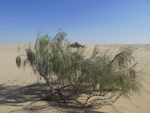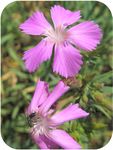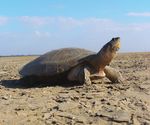Global conservation translocation perspectives: 2021 - IUCN SSC Conservation Translocation Specialist Group - Cutgana
←
→
Page content transcription
If your browser does not render page correctly, please read the page content below
Global conservation translocation perspectives: 2021 IUCN SSC Conservation Translocation Specialist Group
Translocation of Dianthus rupicola Biv. subsp.
rupicola in the Nature Reserve “Isola Lachea e
Faraglioni dei Ciclopi”, Sicily, Italy
Gian Pietro Giusso del Galdo*, Cristina Blandino, Veronica Ranno & Saverio Sciandrello
Department of Biological, Geological and Environmental Sciences, University of Catania,
via A. Longo 19, Catania, Sicily, Italy * - g.giusso@unict.it
Introduction
Dianthus rupicola Biv. subsp. rupicola (fam. Caryophyllaceae) is an endemic
species of southern Italy (Campania, Basilicata and Calabria) and Sicily. It is a
chasmophyte that grows on steep rocky outcrops and coastal cliffs within the
thermo- and meso-Mediterranean bioclimatic belts, from sea level up to about 800
m a.s.l. It forms small shrubs with erect stems and pink flowers that appear from
late spring to autumn (Pignatti, 1982). Flowers are insect pollinated and seeds are
dispersed by gravity, lacking clear long distance dispersal mechanisms. In Sicily,
D. rupicola subsp rupicola is found mostly on carbonatic substrates, except for a
couple of very few-numbered populations growing on volcanic rocks located in the
north-eastern sector of the island. This taxon is included in the Annex II and IV of
the Habitat Directive (92/43/EEC) and is listed in the category “Least Concern” in
the Red List of the Italian Flora (Rossi et al., 2013) while the species is evaluated
as “Near Threatened” at European
level (Bilz et al., 2011). The main
threat to Dianthus rupicola subsp.
rupicola is represented by habitat
modification, both in terms of rock
quarries or urban sprawl (e.g.
touristic infrastructures, etc.) and,
likely most severe, by invasive alien
species (IAS) as, for example,
Opuntia sp. pl.
Goals
Seed collection, development
of germination protocols and
plant production (nursery).
Establishment of a new
population within the Nature
Reserve “Isola Lachea e
Faraglioni dei
Ciclopi” (eastern Sicily).
Eradication of invasive alien
species (mostly Opuntia ficus Close-up of Dianthus rupicola flower
303-indica L.) in an area of ~10,000 m2 .
Restoration of the natural vegetation within the reserve using native
species (e.g. Euphorbia dendroides L., Matthiola incana L., Olea europaea
L. var. sylvestris, Pistacia lentiscus L. and Rhamnus alaternus L.).
Implementation of a long-term monitoring plan.
Success Indicators
Achievement of a germination percentage >85% for the seeds collected
and used in the project.
Production of 300 plants from seeds (sampled on volcanic population) to be
used for the introduction.
Establishment of viable population of Dianthus rupicola subsp. rupicola in
the Nature Reserve “Isola Lachea e Faraglioni dei Ciclopi”.
Establishment of viable populations of Euphorbia dendroides, Matthiola
incana, Olea europaea var. sylvestris, Pistacia lentiscus and Rhamnus
alaternus.
Reduction (75%) of the area invaded by IAS.
Project Summary
Feasibility: In Sicily, there are just two populations of Dianthus rupicola subsp.
rupicola growing on volcanic substrates. One is located within the SCI ITA
070004 “Timpa di Acireale” and another one is found close to the Vallone
Calcarone (Militello Val di Catania). Both are threatened by soil erosion and by
invasive alien species, particularly by Opuntia ficus-indica. The loss of habitat and
the competition with invasive alien species are, globally, recognized among the
major drivers of biodiversity loss. To address these points within the CARE-
MEDIFLORA project and to preserve the unique adaptation of the “Timpa di
Acireale” population, we decided to introduce this genotype to a nearby volcanic
islet, namely Isola Lachea, falling within the Nature Reserve “Isola Lachea and
Faraglioni dei Ciclopi”.
The Lachea islet has
been managed as a
private property for part
of its history and there is
still plenty of exotic
vegetation on it.
Therefore, the
introduction of Dianthus
rupicola subsp. rupicola
has to be coupled with by
the restoration of the
native vegetation and the
eradication of invasive
alien species.
Transplanted Dianthus rupicola plant
304Our target species was absent from
the islet, but the environmental
conditions are suitable for it, and
may have occurred here in the past.
Currently, the introduction area is
managed by CUTGANA, an
institution devoted to the
management and conservation of
natural ecosystems. All the actions
(eradication of IAS, plants
introduction, natural vegetation
restoration, and long term
management plan) have been
agreed and realized by us, in
collaboration with CUTGANA.
In order to maximize the survival
rate of the introduced specimens,
we planted both juvenile plants and
seeds. The plants were produced
from seeds collected from the
population of “Timpa di Acireale”, Transplanting Dianthus rupicola plants
previously tested at the Seed Bank in cleared sites
of the University of Catania to
assess their viability and germination requirements.
Finally, the location of the introduction site within a protected area and the
involvement of the CUTGANA staff will ensure the protection of the new
population and the monitoring of invasive species.
Implementation: The Botanic Garden of the University of Catania, in
collaboration with a private company, provided the facilities and the expertise to
produce Dianthus rupicola subsp. rupicola from seed. In addition, plants of
Euphorbia dendroides, Matthiola incana, Olea europaea var. sylvestris, Pistacia
lentiscus and Rhamnus alaternus have been produced for the habitat restoration.
Before reintroducing the plants, the manual eradication of Opuntia ficus-indica
from about 10,000 m2 of the nature reserve was carried out with the support of a
specialized company, CUTGANA personnel and staff from the University of
Catania. Eradication of Opuntia ficus-indica was not performed on the steepest
cliffs, also for not causing slope instability, but the nature reserve is being
thoroughly monitored for any establishment or resprouting of O. ficus-indica in the
eradicated areas. On February 2018 and March 2019 the planting of Dianthus
rupicola subsp. rupicola, as well as of Euphorbia dendroides, Matthiola incana,
Olea europaea var. sylvestris, Pistacia lentiscus and Rhamnus alaternus have
been carried out.
305Eradicating Opuntia cactus (left) and cleared transplant site (right)
Post-planting monitoring:
The survival rate of introduced individuals is our success indicator both for
the introduction of Dianthus rupicola subsp. rupicola and for the habitat
restoration.
Number of surviving individuals will be periodically counted on sample
areas.
Since the end of the project, the site will be monitored twice a year by the
staff of CUTGANA in collaboration with the University of Catania.
The area where Opuntia ficus-indica was eradicated will be also monitored
by the staff of the nature reserve and, if necessary, new eradication actions
will be implemented.
Major difficulties faced
Removal of Opuntia ficus-indica from the whole reserve.
Irrigation of the newly planted specimens, due to scarcity of water available
in the islet.
Restoration of the steepest cliffs of the Nature Reserve.
Excessive presence of rats and seagulls.
Reachability of the islet in some periods of the year (i.e. autumn - winter).
Major lessons learned
Before introducing a population to a new site, the habitat has to be restored
to the appropriate conditions for the species to be introduced.
The use of juvenile plants instead of seed is more effective.
Development of germination and cultivation protocols for the species to be
reintroduced is fundamental.
Occurrence of potential damaging animals has to be monitored.
306Success of project
Highly Successful Successful Partially Successful Failure
Reason(s) for success:
Lack or scarcity of water.
Excessive summer drought may reduce survival rate of the plants.
Control of potential damaging animals, e.g. rats.
Acknowledgments
We thank the MAVA Foundation for supporting the CARE-MEDIFLORA project. Many
thanks are also due to all the people who gave their contribution to the in situ
conservation of Dianthus rupicola subsp. rupicola, especially the CUTGANA staff.
References
Bilz, M., Kell, S.P., Maxted, N., & Lansdown, R.V. (2011) European red list of
vascular plants. Luxembourg: Publications Office of the European Union.
Pignatti S. (1982) Flora d’Italia I-III. Edagricole, 2324 pp.
Rossi, G., Montagnani, C., Gargano, D., Peruzzi, L., Abeli, T., Ravera, S., et al.
(2013) Lista rossa della flora Italiana. 1. Policy species e altre specie minacciate.
Rome, Italy: Comitato Italiano IUCN e Ministero dell’Ambiente e della Tutela del
Territorio e del Mare.
.
307You can also read


























































